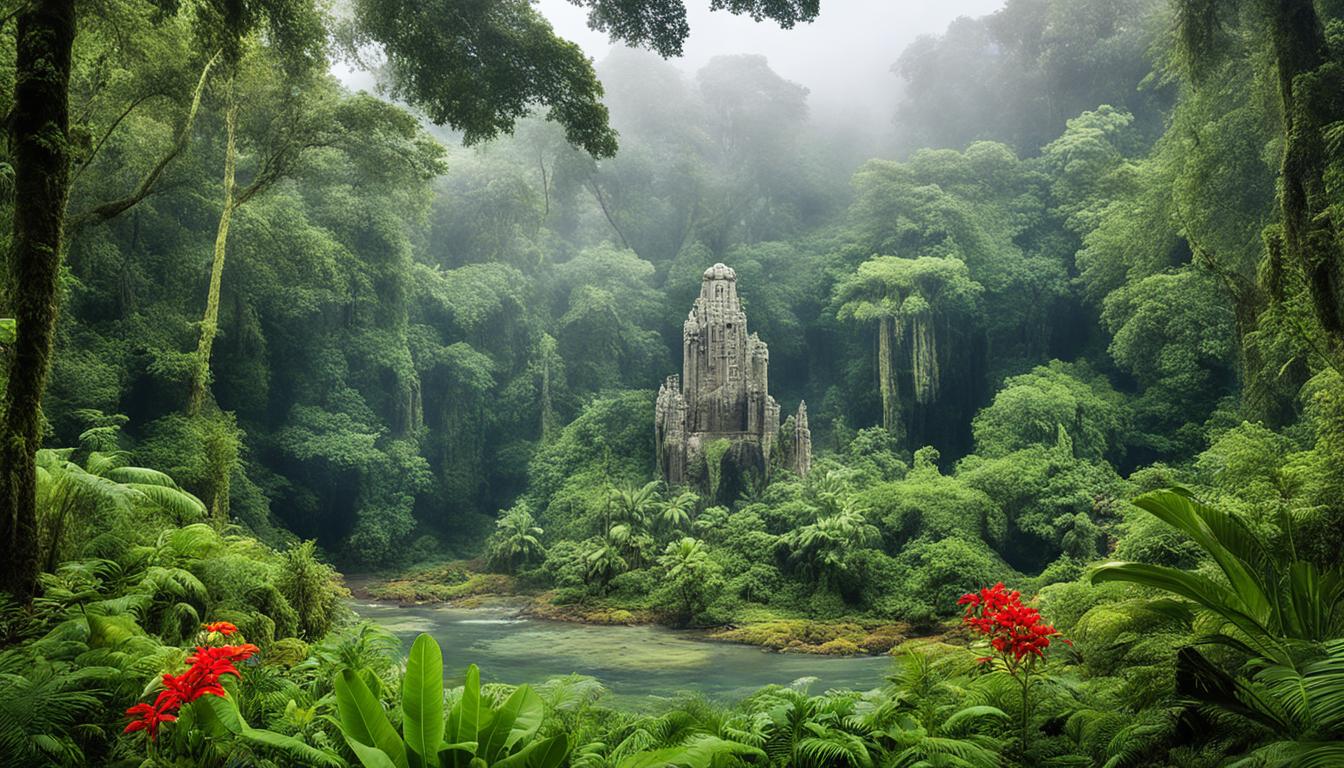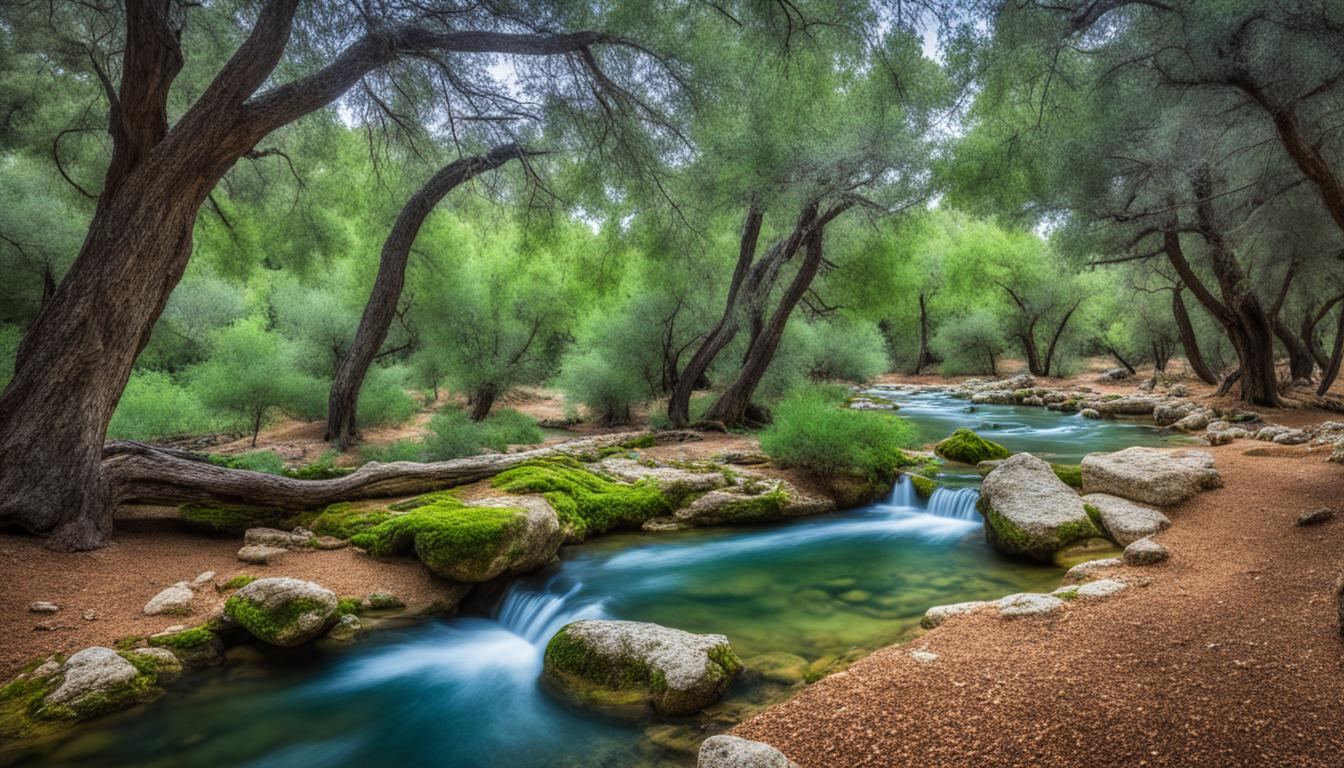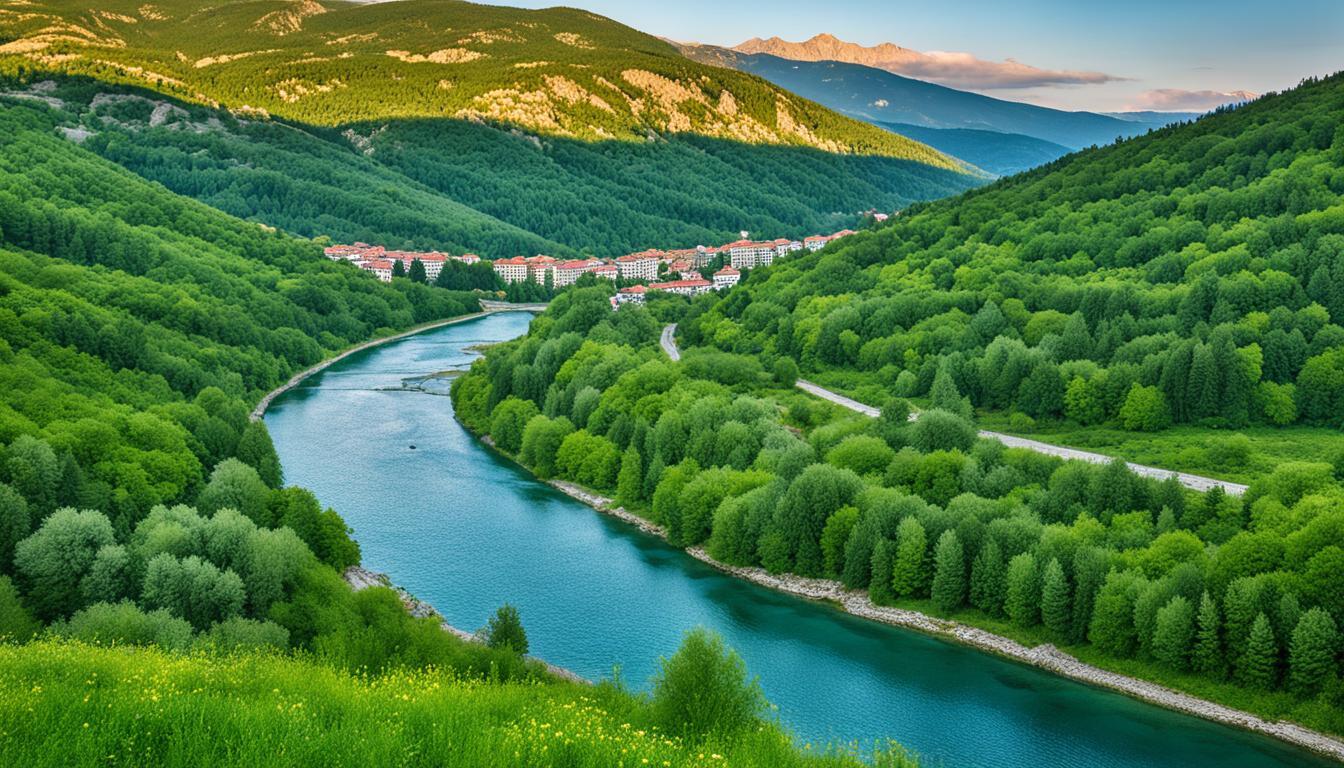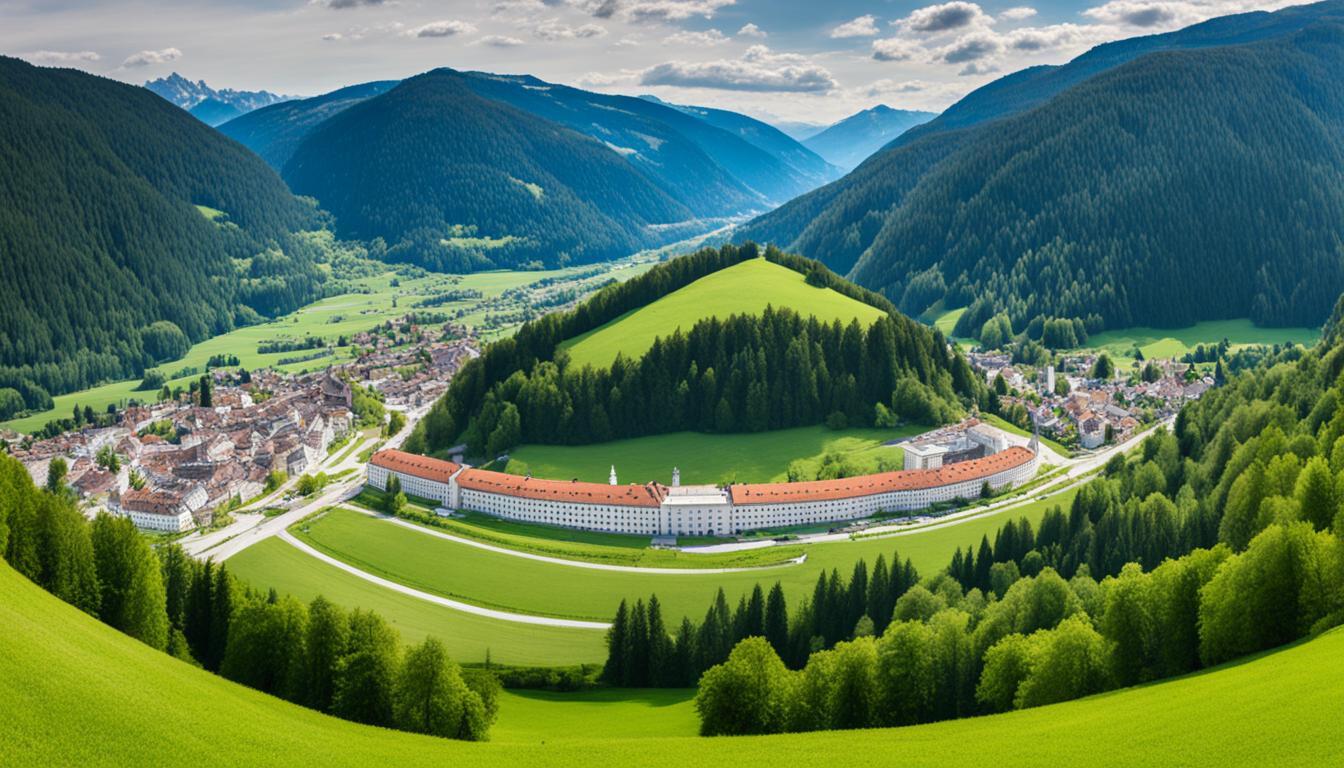Cuba Sacred Natural Sites and Biodiversity
Did you know that Cuba, the largest island nation in the Caribbean, boasts an astounding 4,000 islands and keys? This archipelago is not only a tropical paradise but also a haven for biodiversity and sacred natural sites that capture the imagination. With approximately 50% of its plants and 32% of its vertebrate animals found nowhere else on earth, Cuba is a treasure trove of unique species and ecosystems.
Key Takeaways:
- Cuba is home to a wide range of endemic plant and animal species, making it a biodiversity hotspot.
- The country’s unique ecosystems, including rainforests, wetlands, and coral reefs, contribute to its rich natural diversity.
- Cuba has implemented significant conservation efforts, including the establishment of protected areas and national parks.
- Collaborations between international organizations and Cuban scientists play a crucial role in advancing conservation initiatives.
- Cuba’s natural heritage, recognized by UNESCO World Heritage Sites, holds immense value on a global scale.
Explore the Rich Biodiversity of Cuba
Cuba is renowned for its abundant and diverse wildlife, making it a paradise for nature enthusiasts and conservationists. The country boasts a wide range of unique plant and animal species, thriving in its various ecosystems that include lush rainforests, expansive wetlands, and vibrant coral reefs. Cuba’s commitment to preserving biodiversity is evident through its protected areas and sanctuaries that safeguard its natural heritage.
One of the remarkable aspects of Cuba’s biodiversity is the presence of numerous endemic species found nowhere else in the world. These species have evolved in isolation, adapting to the distinct environmental conditions of the island. For instance, the Zapata wetlands are home to the critically endangered Cuban crocodile, a species found exclusively in Cuba’s sanctuaries. Another remarkable resident of Cuba is the bee hummingbird, the world’s smallest bird, known for its vibrant colors and hovering flight. These unique species are testaments to Cuba’s ecological diversity and its efforts to preserve its natural treasures.
“Cuba’s biodiversity is a source of pride and fascination. It is a living testament to the country’s commitment to protect and conserve its natural heritage.” – Dr. Ana Garcia
Cuba’s biodiversity extends beyond its charismatic flagship species. The country’s ecosystems support a vast array of flora and fauna, sustaining intricate food webs and ecological interactions. The coral reefs surrounding the island are teeming with vibrant marine life, including colorful fish, sea turtles, and delicate coral formations. The rainforests are home to a tapestry of plant species, providing vital habitat for a variety of mammals, birds, and reptiles. The wetlands, such as the Ciénaga de Zapata Biosphere Reserve, serve as important stopover sites for migratory birds, highlighting Cuba’s significance in international bird conservation efforts.
The preservation of Cuba’s biodiversity is not only crucial for the country but also for the global community. The unique species and ecosystems found in Cuba contribute to the overall balance of biodiversity on our planet. They offer valuable insights into evolution, biogeography, and ecological processes. Protecting Cuba’s natural heritage requires ongoing research, conservation efforts, and sustainable practices that balance human needs with the preservation of the environment.
Did You Know?
- Cuba is home to over 350 species of birds, making it a birdwatcher’s paradise.
- The coral reefs surrounding Cuba are part of the Mesoamerican Barrier Reef System, the second-largest barrier reef in the world.
- Cuba’s forests are home to the endangered Cuban solenodon, a small nocturnal mammal with venomous saliva.
By exploring and appreciating Cuba’s rich biodiversity, we can develop a deeper understanding of our interconnectedness with nature and the importance of its conservation. The continued protection of Cuba’s natural treasures ensures that future generations can marvel at the wonders of its unique ecosystems and endemic species.
Conservation Efforts in Cuba
Cuba is renowned for its commitment to conservation and environmental preservation. The country has implemented a range of initiatives to protect its natural resources and biodiversity, ensuring the safeguarding of its unique ecosystems.
One of the key strategies employed by Cuba is the establishment of protected areas and national parks. These designated areas act as havens for endangered species and serve as invaluable habitats for a diverse range of plants and animals. Through the creation of these protected areas, Cuba aims to mitigate the threats posed by habitat loss and unsustainable human activities.
These protected areas also provide invaluable opportunities for scientific research and environmental education. Scientists and researchers have the opportunity to study the diverse range of flora and fauna found within these regions, helping to expand our knowledge of Cuban environmental preservation. Furthermore, these areas serve as educational hubs, where visitors can learn about the importance of conserving our natural heritage.
Furthermore, the Cuban government has implemented regulations to promote sustainable practices, including sustainable fishing and wildlife management. These measures aim to preserve the delicate balance of ecosystems and ensure the long-term viability of valuable resources. By prioritizing sustainability, Cuba showcases its dedication to responsible natural resources management.
Collaboration between the American Museum of Natural History and Cuban scientists is a testament to Cuba’s commitment to conservation and research. Together, they work on various initiatives, sharing knowledge and expertise to further enhance conservation efforts and promote environmental awareness.
Cuba’s conservation efforts extend beyond its borders. The country actively participates in international collaborations and initiatives, working with global partners to address environmental challenges on a larger scale. By joining forces with other nations, Cuba aims to leverage collective knowledge and resources to tackle pressing issues such as climate change and biodiversity loss.
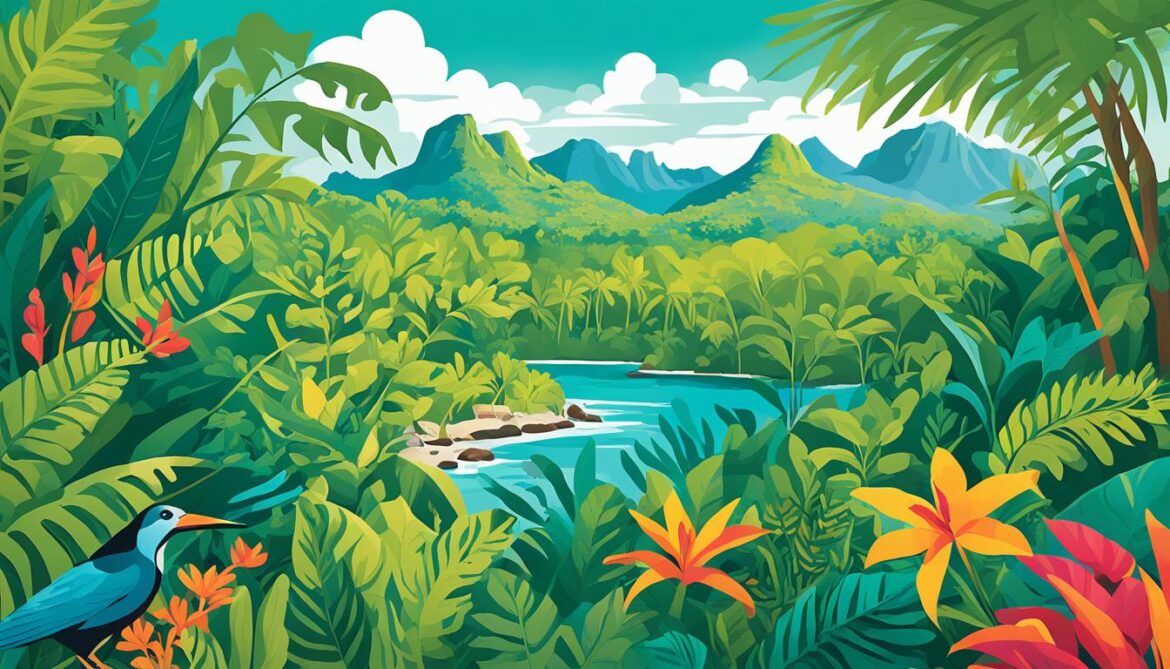
Conservation Achievements in Cuba
The measurable impact of Cuba’s conservation efforts is evident in various achievements. The table below highlights some notable achievements in Cuba’s environmental preservation:
| Achievement | Year |
|---|---|
| Establishment of Guanahacabibes Biosphere Reserve | 1987 |
| Eligibility for UNESCO World Heritage Sites | 2017 |
| Reduction in deforestation rates | 31% since 2004 |
| Implementation of sustainable fishing practices | Ongoing |
| Conservation of endangered species such as the Cuban crocodile | Ongoing |
These achievements demonstrate the success of Cuba’s conservation efforts and highlight the country’s ongoing dedication to protecting its natural heritage.
In summary, Cuba’s conservation efforts encompass the establishment of protected areas, sustainable practices, international collaborations, and a commitment to research and education. Through these multifaceted approaches, Cuba strives to preserve its unique ecosystems, protect endangered species, and ensure the sustainable management of its natural resources.
The Importance of Cuba’s Natural Heritage
The natural heritage of Cuba holds significant importance on a global scale. The country’s unique ecosystems and endemic species contribute to the overall biodiversity of the planet. Cuban natural sites are not only valuable in terms of their ecological diversity but also serve as important research sites for scientists studying evolution, biogeography, and conservation. Additionally, Cuba’s natural resources, such as its coral reefs, play a crucial role in supporting the livelihoods of local communities through activities like tourism and fishing.
Ecological Diversity in Cuba’s Sanctuaries
Cuba’s sanctuaries and protected areas house an astonishing array of plant and animal species, representing a diverse range of ecological communities. The country’s forests, wetlands, mountains, and coastal regions are home to countless unique organisms that have evolved over millions of years. These sanctuaries provide a refuge for endangered species and support the delicate balance of nature.
“Cuba’s natural heritage is a treasure trove for scientists and researchers. It offers unparalleled opportunities to study the evolution of species, the intricate relationships between organisms, and the effects of environmental change. The knowledge gained from studying Cuba’s biodiversity contributes not only to conservation efforts on the island but also to global environmental understanding and stewardship.” – Dr. Maria Perez, Cuban Ecologist
Role of Cuban Natural Resources Management
Cuba’s commitment to natural resources management plays a pivotal role in preserving the country’s rich biodiversity. The government has implemented strategies to ensure sustainable practices in fishing, agriculture, and land use, aiming to minimize the negative impact on fragile ecosystems. By maintaining a delicate balance between human activities and nature, Cuba strives to protect its natural heritage for future generations.
Preserving Cultural and Natural Values
Preserving Cuba’s natural heritage is not only about conserving the extraordinary ecosystems but also about recognizing the cultural significance intertwined with them. Many of the sacred natural sites in Cuba hold deep spiritual and historical importance for the local communities. By conserving these sites, Cuba honors its cultural heritage while safeguarding the ecological diversity that sustains them.
The Image of Cuba’s Natural Heritage

Conservation for Future Generations
Ensuring the long-term protection of Cuba’s natural heritage requires a collective effort from government bodies, organizations, and individuals alike. Education and awareness programs are essential for fostering a sense of environmental stewardship among the Cuban population. By instilling a love and respect for nature in future generations, Cuba can continue to safeguard its unique ecosystems and preserve them for years to come.
| Benefits of Preserving Cuba’s Natural Heritage | Examples |
|---|---|
| Scientific Research | Studying endemic species and evolutionary processes |
| Economic Sustainability | Tourism revenue from eco-tourism and wildlife observation |
| Environmental Education | Creating awareness and promoting conservation practices |
| Cultural Preservation | Protecting sacred natural sites with cultural significance |
Collaborations for Conservation
Collaborations between international organizations and Cuban scientists have played a vital role in advancing conservation efforts in Cuba. In particular, the American Museum of Natural History has established a close working relationship with the Cuban National Museum of Natural History and other institutions to conduct research and expeditions aimed at better understanding Cuba’s biodiversity and contributing to its conservation.
These collaborations have been instrumental in building knowledge and creating sustainable strategies for preserving Cuba’s natural heritage. By pooling resources, expertise, and technology, international and Cuban scientists have made significant progress in identifying and protecting important ecological areas, developing conservation plans, and implementing sustainable practices.
The American Museum of Natural History
“Our collaboration with the Cuban National Museum of Natural History and other Cuban institutions has been incredibly productive. Together, we have conducted field research, biodiversity surveys, and conservation projects that have made significant contributions to Cuba’s conservation efforts. It is a true partnership that highlights the collective commitment to the preservation of Cuba’s unique ecosystems and endemic species.” – Dr. Maria Rodriguez, Senior Scientist at the American Museum of Natural History
Through joint expeditions, scientists have been able to explore and document previously uncharted areas, discovering new species and gathering data on rare and endangered plants and animals. These efforts have not only enhanced scientific understanding but also provided valuable information for conservation planning and decision-making.
Furthermore, these collaborations have facilitated knowledge exchange between Cuban scientists and their international counterparts. This exchange of ideas, techniques, and best practices has enriched scientific understanding and fostered innovation in conservation strategies and management approaches.
The strong partnerships between international organizations and Cuban scientists demonstrate the collective commitment to Cuba’s conservation efforts. Collaboration is key to overcoming the challenges faced in preserving Cuba’s natural resources, including habitat loss, climate change, and unsustainable human activities.
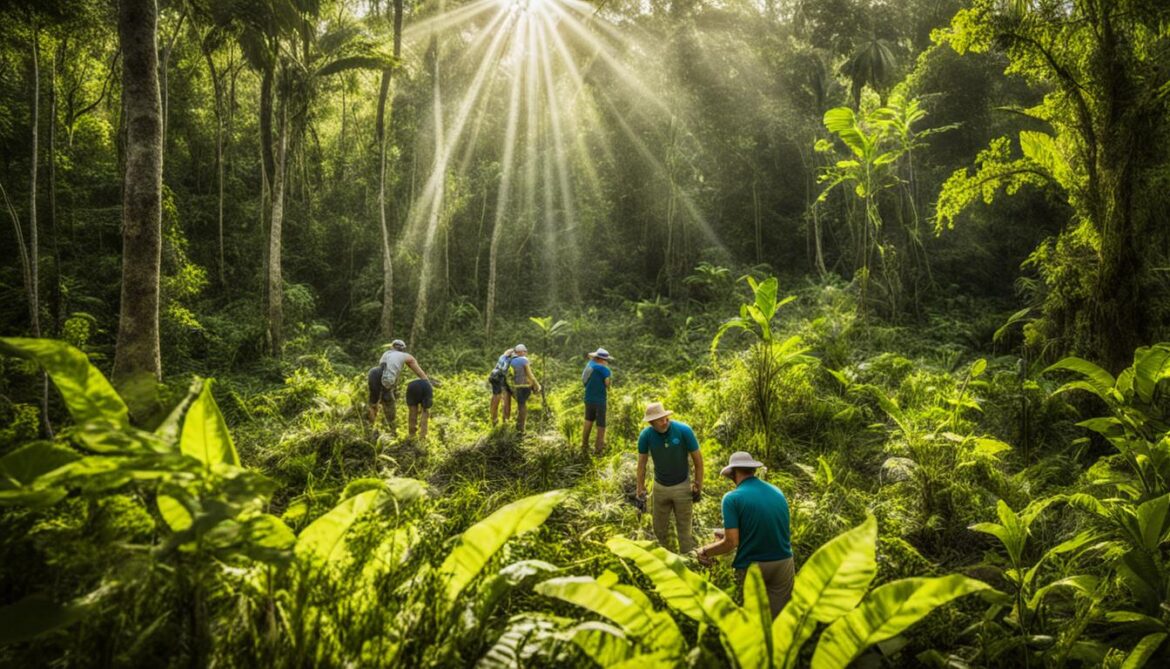
The image above showcases the dedication of researchers and conservationists working together to protect Cuba’s natural heritage and ensure the long-term sustainability of its unique ecosystems.
Climate Change and Conservation Challenges
Like many other countries, Cuba faces the challenges posed by climate change, which can have significant impacts on its natural heritage. Rising temperatures, sea-level rise, and extreme weather events can threaten ecosystems and species.
Cuba’s conservation efforts must also address issues such as invasive species, habitat loss, and unsustainable human activities. These factors can disrupt the delicate balance of ecosystems and put vulnerable species at risk. It is crucial for Cuba to implement environmental preservation measures that promote sustainable practices and protect critical habitats.
“Climate change is a global issue that demands local solutions. In Cuba, we are working tirelessly to preserve our unique wildlife and ecosystems in the face of these challenges. By collaborating with international partners and implementing sustainable practices, we can ensure that future generations can enjoy the beauty of our natural heritage.”
The conservation community in Cuba is actively working to mitigate these challenges and develop strategies to adapt to the changing climate. Scientists and researchers are studying the effects of climate change on Cuba’s biodiversity and using this knowledge to inform conservation efforts.
Cuba Wildlife Conservation: Protecting Endangered Species
A key focus of Cuba’s conservation efforts is the protection of endangered species. The country is home to several iconic species that are at risk of extinction, such as the Cuban crocodile and the Cuban hutia. Conservation initiatives are being implemented to safeguard these species and their habitats.
The Cuban government, in collaboration with international organizations and local communities, is working to establish protected areas and wildlife sanctuaries where endangered species can thrive. These protected areas serve as important refuges for threatened wildlife and play a crucial role in Cuba’s wildlife conservation efforts.

Addressing Climate Change through Sustainable Practices
Sustainable practices are key to mitigating the effects of climate change and preserving Cuba’s natural heritage. The country is implementing measures to reduce its carbon footprint and promote environmentally friendly practices.
- Encouraging renewable energy sources such as solar and wind power
- Implementing sustainable farming practices to protect soil quality
- Promoting responsible tourism to minimize negative impacts on ecosystems
- Supporting research and education on climate change and conservation
These sustainable initiatives are crucial in ensuring a sustainable future for Cuba’s natural resources and wildlife.
World Heritage Sites in Cuba
Cuba boasts several UNESCO World Heritage Sites that recognize the country’s exceptional cultural and natural value. These sites encompass vast areas of protected wilderness, including the stunning Viñales Valley and the breathtaking Desembarco del Granma National Park.
In the Viñales Valley, visitors are treated to a mesmerizing landscape of lush green tobacco fields, dramatic limestone formations known as mogotes, and traditional agricultural practices that have remained unchanged for centuries. This area is not only a visual delight but also an important site for biodiversity conservation.
Desembarco del Granma National Park, on the other hand, offers a unique glimpse into Cuba’s geological history. The park features magnificent coastal cliffs, ancient caves, and untouched forests that are home to a diverse array of flora and fauna.
Both the Viñales Valley and Desembarco del Granma National Park exemplify Cuba’s commitment to preserving its natural heritage for future generations. These sites have been designated as World Heritage Sites to promote international recognition and support for their conservation and preservation efforts.
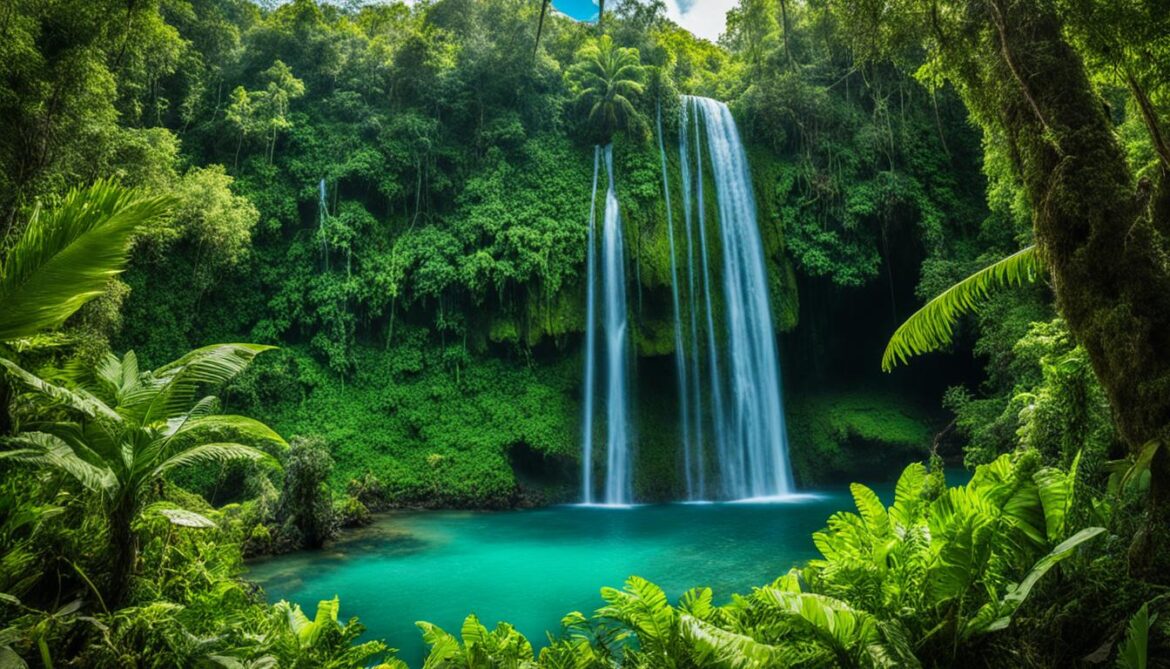
Viñales Valley
The Viñales Valley is located in the western part of Cuba and is known for its stunning natural beauty and unique agricultural practices. This picturesque valley is characterized by its limestone hills, known as mogotes, which rise dramatically from the surrounding flatlands. The valley is also famous for its tobacco fields, where farmers continue to cultivate tobacco using traditional methods. The combination of natural and cultural features makes the Viñales Valley a truly exceptional site.
Desembarco del Granma National Park
Desembarco del Granma National Park is located on the southern coast of Cuba and covers an area of approximately 275 square kilometers. The park is named after the place where Fidel Castro and his comrades landed in 1956 during the Cuban Revolution. The park features breathtaking coastal cliffs, pristine forests, and ancient caves, providing a haven for diverse plant and animal species. Its geological formations are of great scientific importance, showcasing the island’s geological history over millions of years.
| World Heritage Site | Location | Description |
|---|---|---|
| Viñales Valley | Western Cuba | A stunning landscape of limestone hills and traditional tobacco fields |
| Desembarco del Granma National Park | Southern coast of Cuba | Coastal cliffs, ancient caves, and pristine forests with unique biodiversity |
The Future of Conservation in Cuba
The future of conservation in Cuba depends on a collective effort involving the Cuban government, international partners, and local communities. Together, they must address emerging conservation challenges and prioritize the long-term protection of Cuba’s natural heritage.
Collaboration is key to the success of conservation efforts in Cuba. By working together, stakeholders can share knowledge and resources, ensuring that the most effective strategies are implemented. International partners can provide expertise and support, while local communities can contribute their valuable insights and traditional knowledge.
Research plays a vital role in shaping the future of conservation in Cuba. By conducting thorough studies and scientific investigations, stakeholders can gain a deeper understanding of the country’s unique ecosystems and the threats they face. This knowledge forms the foundation for evidence-based decision-making and the development of sustainable practices.
Education and awareness programs are crucial components of conservation efforts in Cuba. By fostering a sense of stewardship towards the environment, these initiatives empower individuals and communities to actively participate in conservation activities. Through education, people can appreciate the value of Cuba’s natural resources and understand the importance of their preservation for future generations.
“Conservation is a shared responsibility, and every individual has a role to play in protecting Cuba’s natural heritage.”
The Role of Cuban Natural Resources Management
A well-managed approach to Cuba’s natural resources is vital for long-term conservation success. Sustainable practices, such as responsible tourism, controlled fishing, and effective wildlife management, are essential to ensure the preservation of Cuba’s unique ecosystems and biodiversity.
Fostering a Culture of Environmental Preservation
To secure the future of conservation in Cuba, it is necessary to create a culture of environmental preservation. This begins with comprehensive environmental education programs that inspire individuals to value and protect their natural surroundings. Such programs can promote sustainable behaviors and empower communities to actively participate in conservation initiatives.
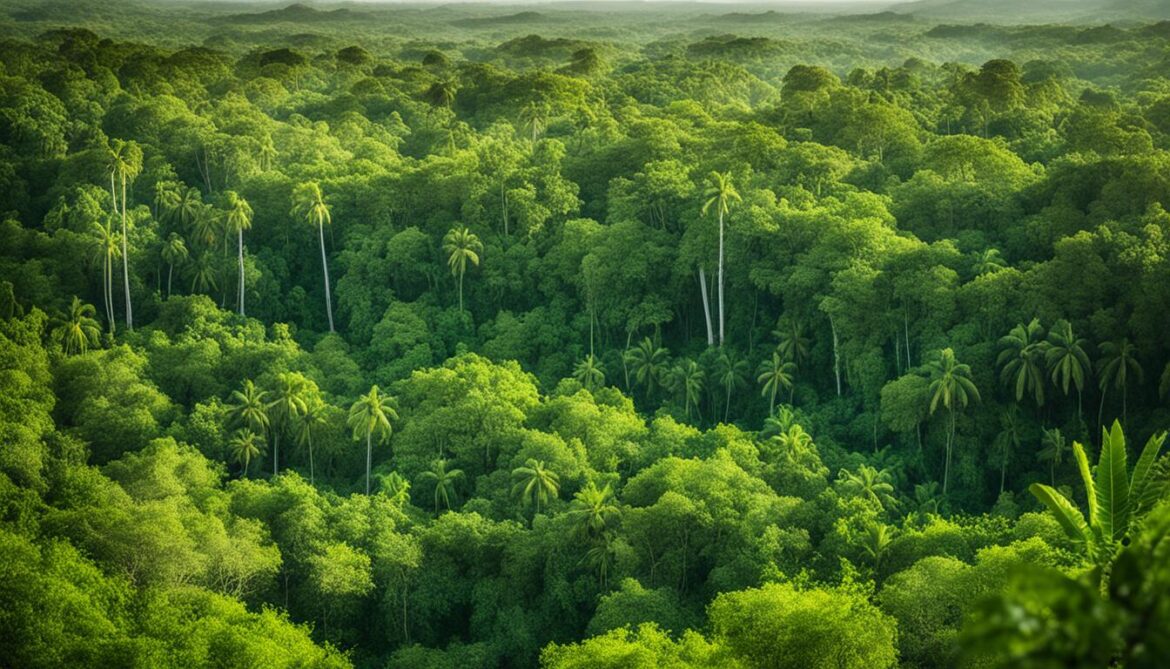
Building Resilience to Environmental Challenges
As Cuba faces ongoing environmental challenges, such as climate change and habitat loss, it is crucial to develop strategies that enhance resilience. By implementing adaptive measures and sustainable practices, Cuba can better respond to the changing conditions and safeguard its natural heritage for future generations to enjoy.
Conclusion
The rich tapestry of Cuba’s sacred natural sites and biodiversity showcases the country’s unwavering commitment to conservation and environmental preservation. With its diverse ecosystems and endemic species, Cuba’s natural heritage holds immense value, not only for the nation itself but also for the global community. Through collaborative efforts and continued dedication, Cuba can safeguard and celebrate its remarkable natural treasures, ensuring their preservation for future generations to cherish.
Cuba’s protected areas, sanctuaries, and national parks serve as vital havens for endangered species and provide opportunities for scientific research and environmental education. By implementing sustainable practices and regulations, such as responsible wildlife management and sustainable fishing, Cuba demonstrates its commitment to preserving its unique natural resources.
The collaborations between international organizations, like the American Museum of Natural History and Cuban scientists, have played a pivotal role in advancing conservation efforts. These collaborations not only contribute to expanding knowledge but also aid in the creation of sustainable strategies that can effectively preserve Cuba’s unparalleled ecological diversity.




